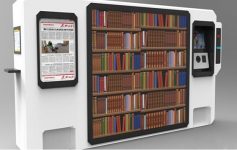
RFID UHF Smart Bookcase
[ad_1]
At present, problems such as low amount of extracurricular reading, less reading of classic books, fragmented reading, etc. are common in the education of universities, middle schools and primary schools. However, there are not many books in the primary and secondary schools, and many schools have dedicated libraries and library rooms. However, the resource utilization rate of primary and secondary school libraries is obviously insufficient. After investigation and analysis, we found that in addition to the high learning pressure of students, the most important problems are: First, the complicated borrowing and returning procedures and harsh borrowing, There are also restrictions; the second is that the library is far away from the classroom, which is not convenient for borrowing and returning; the third is that it is impossible to form a learning atmosphere in which students compete to borrow and read.
Based on the above factors, we use information technology to develop a digital distributed autonomous learning management system (that is, the school distributed library management system), which completely solves the problem of books entering the classroom.
We put the books into the management terminal and distribute them in every classroom or other environment of the school, so that students can fully automate the process of borrowing and returning books, and at the same time, the time of borrowing and returning books, the content of borrowing, the number of readings, etc. The data is automatically recorded to the self-learning management system. At the same time, complete one point of borrowing and return more points. Automate the entire borrowing and returning process.
The digital distributed autonomous learning system is a national patent product, and its software has obtained the national software copyright. According to the characteristics of people’s traditional bookshelves, the product uses information technology to fundamentally solve the problems of people borrowing and returning books, data statistics, analysis, book demand, and information release.
System Features:

1. Simplify the procedures for readers to borrow and return books, shorten the circulation cycle of books, increase the rate of book borrowing, and give full play to the public service function of the bookcase.
2. Improved management efficiency, reduced the labor intensity of management personnel, and greatly improved the efficiency of book inventory and sorting out books on wrong shelves.
3. Make the search of books on the wrong shelf faster and more convenient, further dig out potential book resources, and improve the utilization rate of book materials.
working principle:
First put the books with electronic tags in the library (enter them into the database of the bookcase). When the door of the bookcase is opened, the RFID reader starts to work through the trigger mode, and the RFID reader sends signals through the radio frequency antenna to identify the electronics. Labels, when a book with an electronic label passes through the door of the cabinet, the label data will be collected by the radio frequency antenna and uploaded to the smart bookcase management system through the network port. At this time, the system will display the information in the bookcase. The entry and exit of books, so as to achieve the purpose of statistics and management.

[ad_2]



